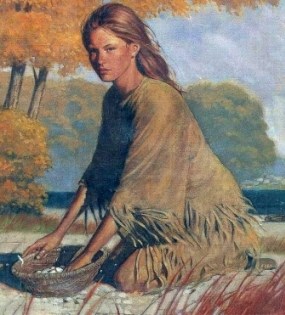
Her life in New Netherland was brief. Anne Hutchinson and her party of fourteen -- six of her younger children, an older daughter and her spouse, followers, and two servants -- reached the area in 1642 by boat from Rhode Island across Long Island Sound. The Hutchinson party seems to have received permission from New Netherland authorities to settle in the area of Vreedlant. The proximity of another exile from Massachusetts and family friend John Throckmorton, who settled with a larger group in what is today the Throg's Neck section of the Bronx, was an additional reason for this location. The Puritan exiles settled on the western side of what later acquired the name of the Hutchinson River, about a mile from St. Paul's Church, and developed a small homestead. (Local historians have long disagreed on the precise location of her home, but it was probably situated near today's Exit 12, Baychester Avenue, off Interstate 95). She made no effort to receive approval from the Lenape to settle on the land, never believing such an overture was necessary. A deeply religious woman, Anne likely trusted in God for protection. Further, her positive relations with the Indians in Massachusetts, where she had opposed the Pequot War, and in Rhode Island perhaps gave her confidence that she could live amicably with the native peoples of New Netherland. Anne hired English carpenters to help build a home, along with her party, and hired hands from the Throckmorton settlement assisted with completion of the homestead. In the space of little more than a year, Anne and her group would have established a farm of subsistence vegetables, primarily corn, peas, beans and squash, cultivated wheat, rye, barley and buckwheat, and harvested salt hay cut from the nearby meadow. They maintained a small set of horses and cattle, for milk and meat, with swine roaming freely in the vicinity. But she was in dangerous territory at a precipitous time. In the midst of the war with New Netherland, the Lenape could not have understood the Hutchinson group as anything but a further Dutch intrusion into their territory. Indian hunters, detecting the Puritans, warned the settlers to depart, tossing the building tools into the river. Anne's son-in-law heeded the notice, returning to New England. While there are no fully reliable contemporary accounts of the attack, one explanation recorded close to the time of occurrence indicates that an Indian war party returned subsequently, in July 1643, and under the pretense of friendship, convinced the exiles to tie up the dogs, before massacring the entire settlement. It is clear that Anne's ten year-old daughter Susanna was spared, a common practice in colonial attacks, and carried off to live for several years as a hostage, or adoptee in the Lenape village. Reflecting a general war against white presence in the vicinity, the Indians marched four miles southeast to Throg's Neck and attacked the Throckmorton settlement, where the settlers escaped on board a ship that happened to be passing through the Sound that day. News of Anne's death reached Boston by August and was quickly interpreted by Winthrop and other Puritan leaders as further evidence of God's displeasure with Mrs. Hutchinson. Twenty years later, when another group of English settlers reached the vicinity in what would become a permanent settlement, the founders of Eastchester, aware of her story, cited the fields and waterways as "Hutchinsons," with references in their earliest document to "where the house stood." |
Last updated: March 31, 2012
